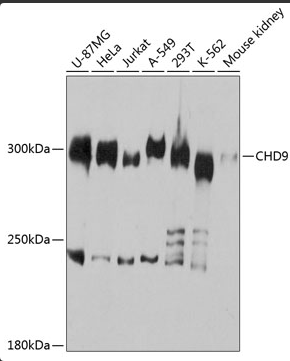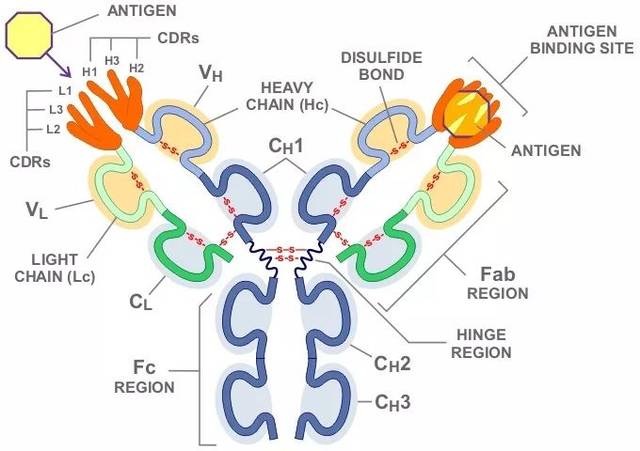Product Name :
CHD9 polyclonal antibody Background :
CHD9 (chromodomain-helicase-DNA-binding protein 9), also known as chromatin-related mesenchymal modulator (CReMM), PPAR-α-interacting complex protein, kismet homolog 2 or CHROM1, is a 2,897 amino acid protein belonging to the Snf2/Rad54 helicase family. The CHD family of proteins are ATP-dependent chromatin remodeling enzymes which combine chromodomains with SWI2/Snf2 ATPase/helicase motifs and DNA-binding capability. Localized to the cytoplasm and the nucleus, CHD9 contains two chromodomains, one ATPbinding helicase domain and one C-terminal helicase domain. Chromodomains are protein regions of about 40-50 amino acid residues found in proteins associated with chromatin remodeling and manipulation. The domain is highly conserved among both plants and animals and is found in a large variety of proteins from many genomes. CHD9 acts as a transcriptional coactivator for PPARα and may also be an ATP-dependent chromatin remodeling protein. CHD9 is widely expressed at low levels and is present as three isoforms produced by alternative splicing. Product :
Rabbit IgG, 1mg/ml in PBS with 0.02% sodium azide, 50% glycerol, pH7.2 Storage&Stability :
Store at 4°C short term. Aliquot and store at -20°C long term. Avoid freeze-thaw cycles. Specificity :
CHD9 polyclonal antibody detects endogenous levels of CHD9 protein. Immunogen :
Recombinant protein of human CHD9 Conjugate :
Unconjugated Modification :
Unmodification
CHD9 polyclonal antibody Background :
CHD9 (chromodomain-helicase-DNA-binding protein 9), also known as chromatin-related mesenchymal modulator (CReMM), PPAR-α-interacting complex protein, kismet homolog 2 or CHROM1, is a 2,897 amino acid protein belonging to the Snf2/Rad54 helicase family. The CHD family of proteins are ATP-dependent chromatin remodeling enzymes which combine chromodomains with SWI2/Snf2 ATPase/helicase motifs and DNA-binding capability. Localized to the cytoplasm and the nucleus, CHD9 contains two chromodomains, one ATPbinding helicase domain and one C-terminal helicase domain. Chromodomains are protein regions of about 40-50 amino acid residues found in proteins associated with chromatin remodeling and manipulation. The domain is highly conserved among both plants and animals and is found in a large variety of proteins from many genomes. CHD9 acts as a transcriptional coactivator for PPARα and may also be an ATP-dependent chromatin remodeling protein. CHD9 is widely expressed at low levels and is present as three isoforms produced by alternative splicing. Product :
Rabbit IgG, 1mg/ml in PBS with 0.02% sodium azide, 50% glycerol, pH7.2 Storage&Stability :
Store at 4°C short term. Aliquot and store at -20°C long term. Avoid freeze-thaw cycles. Specificity :
CHD9 polyclonal antibody detects endogenous levels of CHD9 protein. Immunogen :
Recombinant protein of human CHD9 Conjugate :
Unconjugated Modification :
Unmodification
-
 Western blot analysis of extracts of various cell lines, using CHD9 antibody.
Western blot analysis of extracts of various cell lines, using CHD9 antibody.
Bioworld Biotech only provide peptides for our antibodies and do not provide additional peptide customization services.
Price/Size :
USD 368/1mg/vial
Tips:
For phospho antibody, we provide phospho peptide(0.5mg) and non-phospho peptide(0.5mg).Describe :
Blocking peptides are peptides that bind specifically to the target antibody and block antibody binding. These peptide usually contains the epitope recognized by the antibody. Antibodies bound to the blocking peptide no longer bind to the epitope on the target protein. This mechanism is useful when non-specific binding is an issue, for example, in Western blotting (WB) and Immunohistochemistry (IHC). By comparing the staining from the blocked antibody versus the antibody alone, one can see which staining is specific; Specific binding will be absent from the western blot or IHC performed with the neutralized antibody.Formula:
Synthetic peptide was lyophilized with 100% acetonitrile and is supplied as a powder. Reconstitute with 0.1 ml DI water for a final concentration of 10 mg/ml.The purity is >90%,tested by HPLC and MS.
Storage:
The freeze-dried powder is more stable. For short time at 2-8°C. For long term storage store at -20°C.
Note :
This product is for research use only (RUO only). Not for use in diagnostic or therapeutic procedures.
 CHD9 polyclonal antibody
CHD9 polyclonal antibody  Datasheet
Datasheet COA
COA MSDS
MSDS SHIP
SHIP